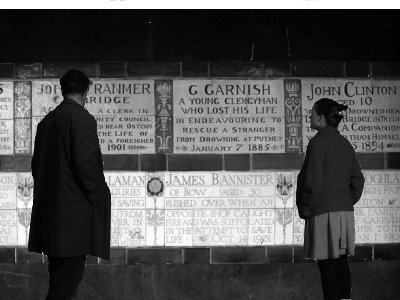closer by patrick marber
see it with your
insignificant other
notes
facts and opinions from the director
postman's park
by tony
tambasco
Postman's Park features prominently in Closer. At the play's opening, Alice has just been visiting, and we soon learn that Dan has significant history at the park, and it is frequeted by Larry as well. The landmark is located between London's King Edward Street and Little Britain and Angel Street.

As in the play, Postman's Park is a memorial garden. It was the idea of the painter George Frederic Watts (1817-1904), who was inspired to create a memorial to ordinary people who had sacrificed their lives to try to save others, who might have otherwise been forgotten. Failing to secure public sponsorship for the park, Watts proceeded to create the memorial himself in 1887.1
The park's memorial consists of 34 painted tiles mounted in a recessed wall. The name comes from the old General Post Office, which was adjacent to the park, and postmen would routinely take their lunches there.
Of particular note is that many of the plaques in the park commemorate the actions (and deaths) of children, while the others celebrate the actions of doctors, policemen, and servants who went above and beyond the call of duty to save ordinary people at the cost of their own lives.2
Thematically, it makes a great deal of sense for Marber to ground so much character history, and ultimately critical action, in this location. Postman's Park is devoted to every day heroes; common people who sacrificed themselves for other common people. The characters in the play come from diverse backgrounds, what they all share in common are human instincts and basic desires to love, to be happy, and to hurt.
"Were the sacrifices worth it?" Marber seems to ask the audience. "Are any of the people we see before you, and all of the terrible things they have done, worth the expenditure of a single human life?" The discomforting answer has us looking less at the stage and more at ourselves. We would do any better, or differently, than the characters in the play? Would any of the Postman's Park martyrs? Had they gone on to live their lives, would they have grown into better human beings?
If survival is not enough, if we must be worthy of surviving, who among us can say that we have done no harm? The plaques of Postman's Park stand as witnesses to the good that men do for the sake of their brother men, but does the good that they have done only live on in the evil of other men?
One of the characters in Closer comments that he hates the park; saying it encourages one to "forget the living3." It is a questions best left to the audience to answer, whether these characters have become worthy of the sacrifice in which their actions are framed.
References
- "Postman's Park - A Little Known City of London Retreat." http://www.urban75.org/london/postman.html. Urban75 Editor. March 2004.
- "Postman's Park and the Painter George Frederic Watts." http://www.victorianweb.org/art/parks/9a.html Dick Sullivan. July 2006.
- Marber, Patrick. Closer. Dramatists Play Service. Nov. 1999. Page 82